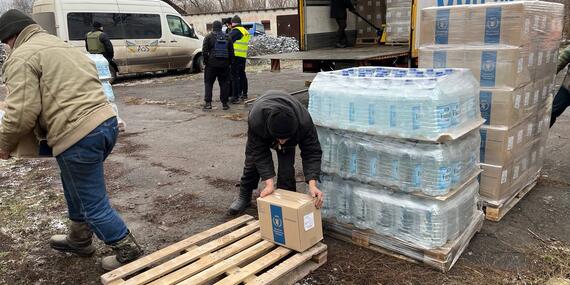Today's top news: Occupied Palestinian Territory, Ethiopia, Ukraine

Occupied Palestinian Territory
The humanitarian pause has now entered its seventh consecutive day. OCHA says this has enabled a major increase in the delivery of basic supplies into and across Gaza, primarily by the Egyptian and Palestinian Red Crescent Societies, and UN agencies. However, as the UN Secretary-General told the Security Council yesterday, the level of aid “remains completely inadequate to meet the huge needs of more than 2 million people.”
Yesterday, UN agencies delivered life-saving medicines and surgical supplies (in addition to fuel) to two hospitals in Gaza City, Al Ahli and Al Sahaba, which are estimated to be sufficient to meet the urgent health needs of 100 patients at each facility.
Despite the pause, there has been almost no improvement in access to water for residents in the north, as most of the main water production facilities remain shut down due to the lack of fuel and to some being damaged.
Enhanced aid distribution, including fuel to hospitals, water and sanitation facilities, and shelters for internally displaced people, also continued in areas south of Wadi Gaza, where the majority of internally displaced people are staying. Cooking gas, which has entered daily from Egypt since the pause began, has been available in the market at one distribution centre in Khan Younis, but in quantities well below demand.
Yesterday, the Director-General of the World Health Organization, Dr. Tedros Adhanom Ghebreyesus, reiterated his concern about the high risk of infectious diseases in shelters for internally displaced people, attributing this to severe overcrowding and the disruption of health, water and sanitation systems. He noted that more than 111,000 cases of acute respiratory infection, 36,000 cases of diarrhoea in children under age 5, and 24,000 skin-rash cases had been recorded since the crisis began.
Ethiopia
OCHA says flooding has affected an estimated 1.5 million people since late October. More than 600,000 people have been displaced.
The floods have caused extensive damage to crops, livestock and vital infrastructure. Houses, shops, schools and agricultural lands are submerged. There is also a rise in health risks with increased cases of cholera, malaria and dengue fever.
Many people are still grappling with five consecutive seasons of severe droughts in the Horn of Africa.
From 24-26 November, the Resident and Humanitarian Coordinator, Ramiz Alakbarov, and the head of the Ethiopian Disaster Risk Management Commission, together with UN and NGO representatives, visited flood-affected areas to assess the situation and explore how to scale up relief efforts.
The UN and our partners are supporting the Government response and providing food, shelter, water and sanitation, as well as logistics support. But the assistance is insufficient.
In addition to increased logistical capacity, we also need increased funding beyond the immediate humanitarian response to help communities adapt to climate change.
This year’s Humanitarian Response Plan for Ethiopia, calling for nearly US$4 billion, is one-third funded, at $1.3 billion.
Ukraine
OCHA says that today marks a significant milestone in the humanitarian response in the country, with the delivery of the 100th inter-agency humanitarian convoy since January of this year.
The Humanitarian Coordinator (HC), Denise Brown, led this latest convoy to deliver items such as food, medical supplies, shelter materials and materials to protect against the winter. These supplies were delivered to the town of Chasiv Yar, in the Donetsk Region, where some 9,000 people out of the pre-war population of 16,000 remain. They have not had water, gas and electricity for more than six months.
Since January, humanitarian convoys have delivered aid to some 390,000 people in the hardest-hit front-line and border communities across six of the most affected oblasts along the front line.
Meanwhile, over the last two days, more reports have emerged about civilians killed and injured, and two hospitals and a pre-school damaged in Donetsk, Zaporizhzhia, Kherson and Sumy regions, in the east, south and north-east of Ukraine.
Sadly, children are also reported to be among the affected. The authorities said that a 7-year-old girl was killed in an attack in the Sumy region on 28 November.
Meanwhile, three children were injured in today’s overnight attacks in the Donetsk Region, in Pokrovsk and Novohrodivka.
Today, the HC visited the site of the attack in Pokrovsk. She again stressed that the delivery of humanitarian assistance to the most affected people will continue as long as the war continues, and that people need humanitarian support.
